Testing Live Weather and Winter Wonders Along the Way
In Microsoft Flight Simulator you can work your way through all kinds of icy scenarios.

This could be an ad for Air Canada. What a scenery feast. Partially frozen waters with glaciers and snow-covered cliffs. Unbelievably beautiful. [Courtesy: Peter James]
With winter gripping most of the country, it’s one of my most favorite times to sim fly. Actually, that’s a lie. All seasons are fun. However, winter does hold that special, adventurous spirit the other seasons sometimes seem to lack.
I am often inspired by the real locations and weather I experience when I am on a real work trip. With ForeFlight by my side, it’s fun to test the realism of the sims and how they're interpreting live weather worldwide. Both X-Plane 12 (XP12) and Microsoft Flight Simulator 2020 (MSFS2020) do a pretty good job of keeping up with it and both have shown continual improvements. It seems each month the message forums are showcasing live weather questions, observations, frustrations, and praise.
I feel the most accurate live weather award currently goes to MSFS2020 as most of the flights I take, with ForeFlight next to me, are startlingly accurate. The altimeter, visibility, and clouds are really spot on. Locations of rain or snow are pretty accurate too with virga and visual depictions often having me saying “wow.”
I made my way westward recently from the East Coast to encounter winter spots. The first was a stop into Cleveland Hopkins International Airport (KCLE) using a 787 Dreamliner. KCLE is known for lake-effect snow and this day didn’t disappoint. Snow bands were flowing west to east, and my flight session, down the ILS to an eventual autoland, took me right in the heart of it all.
Various moments from the cockpit view included bursts of snow whooshing past, some varying visibility, and not a lot of turbulence. Even as shown on ForeFlight, the snow showers ended east of the field near the city, allowing for an almost completely visual approach. As I got closer, some definite wind shear jibs and jabs made the wings bounce, something the 787 is famous for with its dampening, flexing wings.
Testing live weather was a success in this scenario. Let’s see the next one.
I proceeded westward a few hours to the Dakotas and upon reaching there had some very windy weather and snowy bursts to contend with as well. I was using the amazing Learjet 35 I recently featured and it was a blast to feel this one out in surface winds gusting to 40 knots. The Learjet has enough fuel for about 1,500 nm tops, and in this case I traveled about 1,000 miles. I set out for a field in the North Dakota-eastern Montana area for fuel and aircraft change.
The somewhat higher elevations and wide-open areas with some gradual terrain will start making shear. The bumps were noticeable but not yet overly crazy. The wind flow over terrain effect within MSFS is remarkably accurate.
For the next leg of the adventure, I chose the default Cessna Longitude bizjet, with more range and modern avionics to attempt a “visual” in horrendous weather, surrounded by dangerous terrain. Revelstoke, British Columbia, in Canada is spectacular as it gets, so I went to go check it out.
I vectored myself onto the arrival below the terrain. I would be landing on Runway 30 with the poor weather conditions, so I decided to use the modern technology at hand.
Following the 3D view with an eyesight-enhanced vision system on the Latitude, I could see right through the clouds and snow, down the river in virtual visual conditions. Now, I don’t think pilots with this avionics package do this yet, but I could see someday in the not too distant future the ability to just fly a visual approach in something horrendous.
I was led right down the shoot to the breakout point and runway in real visual conditions at a low altitude I would say was near ILS minimums.
In the real Challenger 300 I fly, similar to the Longitude, the reversers are so effective and rev up to such a high percentage, we don’t even touch the brakes until almost walking speed or something under 40 knots.
MSFS has great icing modeled with effects on performance. It doesn’t always come off cleanly, and sometimes even windows don’t get cleared very rapidly.
Continuing the adventure, I got into an A321neo (LatinVFR available on sim marketplace) for the rest of the journey westward. There is no better, more scenic place than Juneau, Alaska, and an unusual weather event was occurring at the time—clear skies! Alaska in winter is usually terrible with huge rain storms likely along the coast or wet snow blizzards. Apparently a cold snap following some heavy snows was occurring the day I tried this, and the built-in live weather matched the conditions almost to a T.
I have to stop somewhere, because the adventuring available in Alaska is endless. Maybe I’ll do this again later this winter as there is so much to discover and tinker with. Setting up manual weather to something wild and dangerous is also fun, especially in mountainous regions. Using the variety of GA aircraft available in the sims opens up a whole new avenue of bush flying, where icing dangers are more noteworthy.
As always, I have to link the “must-haves” as you fly:
FS Realistic Pro for the best add-on ever made.
Sporty’s Pilot Shop for all the flight controls imaginable and an easy home setup.
ProDeskSim for the coolest affordable add-ons to the Honeycomb throttle quadrant that will leave you drooling.

Subscribe to Our Newsletter
Get the latest FLYING stories delivered directly to your inbox






